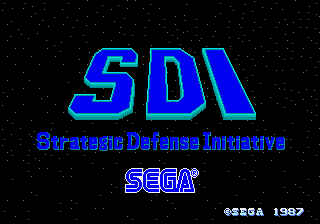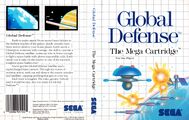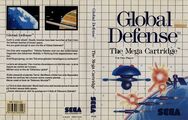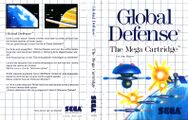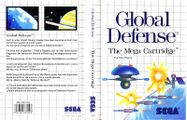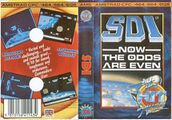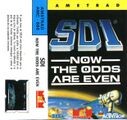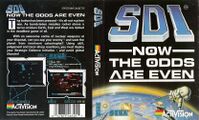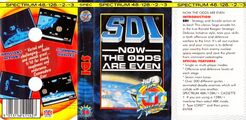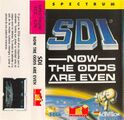SDI: Strategic Defense Initiative
From Sega Retro
| SDI: Strategic Defense Initiative | |||||
|---|---|---|---|---|---|
| System(s): Sega System 16, Sega Master System, Amiga, Amstrad CPC, Atari ST, Commodore 64, ZX Spectrum | |||||
| Publisher: Sega Activision | |||||
| Developer: Sega Pixies Source | |||||
| Genre: Shoot-'em-Up | |||||
| Number of players: 2 | |||||
|
SDI: Strategic Defense Initiative is a 1987 shoot-'em-up arcade game developed by Sega for the Sega System 16 arcade platform.
Contents
Gameplay
Unusual for its time, SDI has the player assume the role of a satellite, tasked with destroying enemy satellites and missiles. Each level is divided into two "modes" - "offensive" mode, which takes the form of a sidescrolling shoot-'em-up, and "defensive" mode which is built more similarly to Atari's Missile Command. Beating both modes allows the player to progress, however, if the player can destroy all the enemies in offensive mode, defensive mode does not take place.
SDI not only gives the player control over the movement of the satellite, but also its aim. This mechanic was implemented in the original arcade cabinet through the form of a joystick and trackball - the joystick moving the player, the trackball moving the crosshair. On the top of the joystick is a button for firing.
A perfect game of SDI will result in the satellite being replaced with Flicky.
Ports
SDI was ported to the Sega Master System in 1987/1988, where western versions were renamed Global Defense. The Master System version, as well as cutting back on the graphical and audio quality, has to vastly reduce the difficulty of the game to match up with a new control scheme - as the console lacks a trackball, the player needs to switch between moving and aiming during play (holding ![]() while moving the D-Pad allows the satellite to move, otherwise the D-Pad only controls the crosshair). This makes moving and aiming at the same time impossible. However, the U.S. manual lists an alternate two-controller configuration in which the first controller aims and the second controller moves the satellite. When the game is started in this configuration, the satellite fires automatically. To start the game with two controllers, on the second controller either press Left and
while moving the D-Pad allows the satellite to move, otherwise the D-Pad only controls the crosshair). This makes moving and aiming at the same time impossible. However, the U.S. manual lists an alternate two-controller configuration in which the first controller aims and the second controller moves the satellite. When the game is started in this configuration, the satellite fires automatically. To start the game with two controllers, on the second controller either press Left and ![]() or Right and
or Right and ![]() .
.
Activision brought the game to home computers in Europe - the Amiga, Amstrad CPC, Atari ST, Commodore 64 and ZX Spectrum (not to be confused with S.D.I., an unrelated game also released for the Amiga and Atari ST).
These days, SDI is often grouped with another arcade game from the era, Quartet. Both were released as part of Volume 21 of the Sega Ages 2500 series, Sega Ages 2500 Series Vol. 21: SDI & Quartet: Sega System 16 Collection for the PlayStation 2. SDI & Quartet: Original Soundtrack contains the official soundtrack of both games.
Production Credits
Arcade Version
Planed by: Black Holl Tomo
Project Leader: Joe Kacchan
Programer: Sweet Tohchan, Anatano Pideshi, Ippo Ogapi
Character Design: Saitama Kenji, 8940 Kon
Scene Design: Henchan
Music by: Funky Gerogero
Sound Effects: Nao Chan
Mechanical Engineer: MI.U.I.Hachi
Enemy Creation: Demon Taka
Data Adjust: Nanno Icchan
Special Thanks: Mina Inochi, Hakusyon Daimaohe, Mamiko Chan, Uso Happyaku
Special No Thanks: Ashidematoi People
Presented by: Sega, Chin_Chin Brothers
- (According to Sega Ages 2500 Vol. 21, Masaki Kondo (近藤 正樹) was a "Designer", Katsumi Tojo (藤乗 勝巳) was the "main programmer" and Eishi Kawatake (川竹 英士) was also a programmer. All three worked on Galaxy Force too).
Commodore 64 Version
(C)1988 Activision
Software Studios
Produced by Neil Jackson
Coding Graphics and Music was Produced by Source the Software House Ltd
Artwork by Bryn Redman, Ross Harris
Music Composed by Paul Summers
Programming by Mike Chilton
Promotional Material
- SDIArcadeUSFlyer.jpg
System 16 flyer
- SDI Computers UK PrintAdvert.jpg
Home computers UK print advert
Physical Scans
Arcade Version
| System 16, JP | ||||
|---|---|---|---|---|
Master System version
| Sega Retro Average | ||||||||||||||||||||||||||||||||||||||||||||||||||||||||||||||||||||||||||
|---|---|---|---|---|---|---|---|---|---|---|---|---|---|---|---|---|---|---|---|---|---|---|---|---|---|---|---|---|---|---|---|---|---|---|---|---|---|---|---|---|---|---|---|---|---|---|---|---|---|---|---|---|---|---|---|---|---|---|---|---|---|---|---|---|---|---|---|---|---|---|---|---|---|---|
|
| 74 | |
|---|---|
| Based on 14 reviews | |
Amiga Version
| Sega Retro Average | ||||||||||||||
|---|---|---|---|---|---|---|---|---|---|---|---|---|---|---|
|
| 54 | |
|---|---|
| Based on 2 reviews | |
| Amiga, UK |
|---|
|
Amstrad CPC Version
| Sega Retro Average | |||||||||||||||||||
|---|---|---|---|---|---|---|---|---|---|---|---|---|---|---|---|---|---|---|---|
|
| 52 | |
|---|---|
| Based on 3 reviews | |
| Amstrad CPC, UK |
|---|
|
Atari ST Version
| Sega Retro Average | |||||||||||||||||||||||||||||
|---|---|---|---|---|---|---|---|---|---|---|---|---|---|---|---|---|---|---|---|---|---|---|---|---|---|---|---|---|---|
|
| 71 | |
|---|---|
| Based on 5 reviews | |
| Atari ST, UK |
|---|
|
Commodore 64 Version
| Sega Retro Average | ||||||||||||||||||||||||||||||||||||||||||||
|---|---|---|---|---|---|---|---|---|---|---|---|---|---|---|---|---|---|---|---|---|---|---|---|---|---|---|---|---|---|---|---|---|---|---|---|---|---|---|---|---|---|---|---|---|
|
| 63 | |
|---|---|
| Based on 8 reviews | |
| Amiga, UK (cassette) |
|---|
|
| Amiga, UK (disk) |
|---|
|
ZX Spectrum Version
| Sega Retro Average | |||||||||||||||||||||||||||||
|---|---|---|---|---|---|---|---|---|---|---|---|---|---|---|---|---|---|---|---|---|---|---|---|---|---|---|---|---|---|
|
| 51 | |
|---|---|
| Based on 5 reviews | |
- ↑ ACE, "November 1988" (UK; 1988-xx-xx), page 49
- ↑ Complete Guide to Consoles, "" (UK; 1989-10-16), page 57
- ↑ Complete Guide to Consoles, "Volume IV" (UK; 1990-11-xx), page 97
- ↑ The Complete Guide to Sega, "" (UK; 1991-05-xx), page 57
- ↑ Console XS, "June/July 1992" (UK; 1992-04-23), page 141
- ↑ Computer & Video Games, "April 1988" (UK; 1988-03-15), page 122
- ↑ The Games Machine, "April 1988" (UK; 1988-03-17), page 43
- ↑ Mean Machines Sega, "October 1992" (UK; 1992-09-xx), page 133
- ↑ Power Play, "Ausgabe 4" (DE; 1988-03-21), page 93
- ↑ S: The Sega Magazine, "July 1990" (UK; 1990-06-07), page 12
- ↑ Sega Power, "October 1991" (UK; 1991-09-05), page 57
- ↑ Sega Pro, "Christmas 1991" (UK; 1991-12-12), page 19
- ↑ Sega Pro, "April 1993" (UK; 1993-03-11), page 71
- ↑ User, "Septémvrios 1992" (GR; 1992-0x-xx), page 86
- ↑ The Games Machine, "September 1989" (UK; 1989-08-18), page 91
- ↑ New Computer Express, "July 15, 1989" (UK; 1989-07-13), page 50
- ↑ ACE, "May 1989" (UK; 1989-04-06), page 78
- ↑ Amstrad Computer User, "May 1989" (UK; 1989-xx-xx), page 36
- ↑ 19.0 19.1 19.2 The Games Machine, "May 1989" (UK; 1989-04-20), page 43
- ↑ ACE, "December 1988" (UK; 1988-xx-xx), page 75
- ↑ Computer & Video Games, "December 1988" (UK; 1988-11-xx), page 58
- ↑ The Games Machine, "xxxx 198x" (IT; 1988-12-15), page 36
- ↑ The Games Machine, "January 1989" (UK; 1988-12-15), page 81
- ↑ Génération 4, "Décembre 1988" (FR; 1988-1x-xx), page 24
- ↑ Commodore Force, "August 1993" (UK; 1993-06-24), page 20
- ↑ Commodore User, "January 1989" (UK; 1988-12-19), page 64
- ↑ Computer & Video Games, "July 1991" (UK; 1991-06-15), page 81
- ↑ Computer & Video Games, "September 1991" (UK; 1991-08-15), page 88
- ↑ Zzap!64, "March 1989" (UK; 1989-02-16), page 21
- ↑ Zzap!64, "July 1991" (UK; 1991-06-13), page 79
- ↑ Zzap!, "Giugno 1991" (IT; 1991-xx-xx), page 51
- ↑ Computer & Video Games, "July 1991" (UK; 1991-06-15), page 85
- ↑ New Computer Express, "December 24, 1988" (UK; 1988-12-22), page 41
- ↑ Sinclair User, "July 1991" (UK; 1991-06-15), page 42
- ↑ Your Sinclair, "July 1991" (UK; 1991-06-xx), page 58
- Pages with broken file links
- 2 player games
- Use romtable template
- All games
- Old-style rating (ace)
- Rating without PDF source
- Old-style rating (cgtc)
- Old-style rating (cvg)
- Old-style rating (gamesmachineuk)
- Old-style rating (s)
- Old-style rating (segapower)
- Old-style rating (segapro)
- Update ratings template
- 8 old ratings
- 1 old ratings
- Rating without source
- 3 old ratings
- 2 old ratings
- System 16 games
